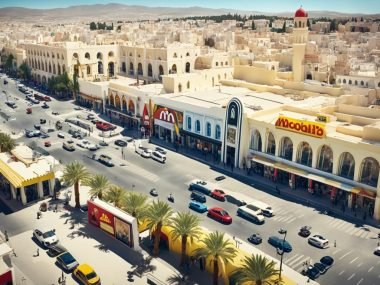Can a nation throw off the chains of tyranny to grow into a democracy? My look into Tunisia’s journey to democracy tells a story of bravery, clever plans, and a constant drive for self-rule. The story begins with the bold Jasmine Revolution in late 2010. People in Tunisia, tired of dictator Zine el Abidine Ben Ali’s rule, protested in the streets. This event was going to change Tunisia’s history. The military’s choice not to shoot the protesters was crucial. This choice showed the commitment to the values of Habib Bourguiba, Tunisia’s first President.
The Tunisian General Labour Union also played a key role. They helped build the push for political change in Tunisia. This set off similar hopes across the region. But Tunisia was unique. While other nations in the Arab Spring fell into chaos, Tunisia became a symbol of hope. It showed that democracy can take root in the Arab world.
Key Takeaways
- The Jasmine Revolution of 2010 was a defining moment in Tunisia’s Democratic Evolution.
- Tunisian citizens courageously stood up against authoritarian rule, leading to the overthrow of Zine el Abidine Ben Ali.
- A particularly notable factor in their success was the military’s choice not to shoot demonstrators, a reflection of republican values.
- Tunisia’s experience has shown the possibility of a peaceful transition to democracy in the Arab world.
- The process for Political Transformation in Tunisia was distinguished by the engagement of civil society and labor unions.
The Jasmine Revolution and the Fall of Ben Ali
Tunisia’s Democratic Evolution reached a pivotal moment with the Jasmine Revolution. It started major changes in Tunisia’s social and political scenes.
The Spark of the Tunisian Revolution
I learned a lot about the Tunisian Revolution when studying a young graduate’s desperate act. In Sidi Bouzid, his action sparked national protests. These protests were about more than joblessness and corruption. They showed a deep wish for a life of dignity, free from unfairness.
Ben Ali’s Regime Collapse
The widespread protests highlighted the Tunisian Revolution’s effect, leading to Ben Ali’s regime falling on January 14, 2011. The quick fall of a strong government was stunning. This government was once seen as legitimate due to rigged elections.
The Military’s Role in the Transition
The Tunisian military chose to remain neutral instead of seizing power. This choice helped ensure a peaceful change. It also protected the early steps towards democracy in Tunisia.
| Event | Date | Impact |
|---|---|---|
| Self-immolation in Sidi Bouzid | December 17, 2010 | Triggered nationwide protests |
| Ben Ali’s Flight to Saudi Arabia | January 14, 2011 | Power vacuum initiated governmental transition |
| Military’s stance on neutrality | January 2011 | Protected the democratic shift |
Reflecting on these events shows the importance of both people and the military. They both helped guide Tunisia to democracy. This changed Tunisia and inspired movements in other areas too.
Paving the Way for Democracy: Tunisia’s Political Transformation
The Tunisian Democratic Process saw big changes after getting rid of the old leader. They formed a group to plan the move to democracy. This group was key in planning how to build a strong democracy.
They quickly made a plan to change the constitution. This plan aimed to reduce the president’s too strong powers. It was a step towards making the government more balanced.
- The Constituent Assembly, elected in October 2011, was instrumental in drafting a new constitution, reflecting the aspirations of all Tunisians.
- An Independent Higher Authority for Elections was established, ensuring the integrity and transparency of future electoral processes.
- The legalization of various political parties provided a pluralistic landscape, allowing diverse political voices to be heard and represented.

This change in Tunisia’s politics means not just fixing the system but also reviving the country’s spirit. When I think about these changes, I see how the Commission and the people’s involvement were key. They helped bring democracy back to life in Tunisia.
The Tunisian Democratic Process has shown others in the area that democracy is possible. It shows that with hard work and working together, big changes can happen.
The Ennahda Party Ascent and Promises of Moderation
The Ennahda Party has gotten a lot of attention since democracy started in Tunisia. It’s seen as a moderate Islamist group. People had mixed feelings about its role in Tunisia’s new democracy.
Islamist Politics and the Question of Democracy
After the revolution, Ennahda became important. It made people wonder if Islamist politics and democracy can mix. The party has a big following. It says it’s all for democracy and wants to include everyone in governing.
Ghannouchi’s Role and Influence
Rachid Ghannouchi leads Ennahda. He supports democracy and keeping Islamist politics moderate. His ideas helped Ennahda gain trust in Tunisia. He talks a lot about keeping laws progressive and not using Sharia law in the constitution.
Tunisia’s politics are changing because of Ennahda and Ghannouchi. They are trying to figure out how Islamist groups fit into democracy. Here’s how Ennahda’s promises are doing in practice:
| Promise | Implementation | Impact on Tunisia’s Democratic Evolution |
|---|---|---|
| Maintain Personal Status Code | Upheld in party policies | Supports women’s rights and secular values |
| Avoid Sharia in Constitution | Sharia not referenced as constitutional basis | Reinforces a secular legal framework |
| Commitment to Democratic Processes | Engaged in coalition government | Promotes political pluralism and stability |
| Pluralism in Governance | Coalition with secular parties | Encourages diverse political representation |
The role of Islamist politics through Ennahda in Tunisia is unique. It shows how they are becoming more moderate. This could really shape Tunisia’s democracy.
Forming a New Government: Tunisia’s Legislative Achievements
Tunisia began a new chapter by drastically changing its government system. This major change highlighted Tunisia’s shift to a more open society. The creation of a new constitution led to the nation’s first democratic elections.

These elections showed the world how far Tunisia has come. They were fair and honest. For the first time, leaders like Béji Caïd Essebsi and Kais Saied were elected by the people.
| Year | Event | Impact |
|---|---|---|
| 2014 | Election of Béji Caïd Essebsi | First democratically elected president, significantly shifting political norms. |
| 2019 | Election of Kais Saied | Elected by a significant margin; represents the continuation of democratic processes. |
| 2021 | Consolidation of power by Kais Saied | Raised concerns about the future of Tunisian Democracy amidst strides in legislative development. |
Despite recent issues, Tunisia’s journey towards democracy is admirable. Its efforts to adopt a democratic system are worth noting. This journey gives hope to others moving from dictatorship to democracy.
Tunisia’s Relationships and Democratic Consolidation
The journey of Tunisian Democracy has milestones and challenges. It shows the hopes and fights of Democracy in North Africa. As Tunisia moves through its Government Transition, we see the importance of domestic and international support. This helps us understand its progress towards democracy more deeply.
Domestic Challenges and International Support
Tunisia’s Government Transition had many domestic problems. These include economic troubles and the need for better security. Despite this, the spirit of Tunisian Democracy stays strong. An active civil society works hard for betterment.
On the international side, ties with countries like the United States, France, and European Union members have helped a lot. This support has given economic help and backed Tunisia’s democratic dreams globally. It creates a good environment for democratic values to grow stronger.
Tunisia in the Broader Arab Spring Context
When we talk about Democracy in North Africa, Tunisia stands out after the Arab Spring. It has made progress in building a democracy that listens to its people. This has given hope to countries globally. It shows that democracy can grow well in the region.
Conclusion
The journey to Political Transformation in Tunisia is truly amazing. It shows that democracy can flourish in the Arab world. The courage of the Tunisian people led to the Tunisian Revolution Impact. They removed a leader who had too much power for too long.
This story is about a nation’s strength. The military chose not to take sides. Labor unions also played a big part. Together, they helped the country move towards democracy.
The rise of the Ennahda Party added a new chapter to the story. It showed that Islamist politics can match democratic values. With a new constitution and fair elections, Tunisia embraced democracy. I admired how these changes built a new Tunisia. Now, it values freedom, responsibility, and fairness for everyone.
But, changing a country is tough. Tunisia faces big challenges that test its democracy. The recent actions of its leaders and some problems inside the country are big tests. Yet, I believe Tunisia’s example after the revolution is powerful. It can inspire others to follow democracy.
I hope Tunisia’s story will encourage democratic efforts in other places. It shows that the wish for self-rule is common everywhere. Even in places you might not expect. This is my lasting hope.







